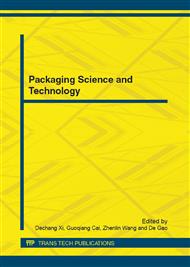p.233
p.237
p.243
p.249
p.254
p.259
p.263
p.267
p.271
Production of Electromagnetic Shielding Boards Using Paper/Plastic/Aluminum Packaging Waste & Copper Fibers
Abstract:
Paper/plastic/aluminum (PPA) multilayer composite is one of the most favorable packaging material for milk and yoghourt because of its excellent material properties, especially the unbreakability, machinability and barrier properties towards moisture, oxygen and light. Ecological demands on littering and on carbon footprint gave pressure on the public community. Together with the increasing amount of PPA packaging containers all over the world, the recollection and recycling of PPA packages was steadily increasing. In this paper, an electromagnetic shielding board was produced with Tetra Pak waste and copper fibers. Electromagnetic shielding effectiveness (SE) and volume resistivity (VR) were investigated. It was found that SE increased with the increased copper fiber content but declined with the increases copper fiber length. However, VR showed an opposite tendency. In the condition of 100 g/m2 copper fiber content and 3-4 mm fiber length, the board showed good shielding performance, e.g., in the range of 9 KHz 5 GHz frequency, the average SE was up to 24.11 dB, and in the range of 600 MHz 1000 MHz frequency, the maximum SE came up to 58.91 dB. Based on the findings of this study, a conclusion could be made that manufacturing electromagnetic shielding boards using PPA packaging waste should be regarded as a step in the prevention of the environmental pollution and as a method of achieving economical worth from these items, and this type board could be considered as an alternative raw material with accepted properties to be used in packaging, interior finish, furniture, and other applications.
Info:
Periodical:
Pages:
254-258
Citation:
Online since:
October 2012
Authors:
Price:
Сopyright:
© 2012 Trans Tech Publications Ltd. All Rights Reserved
Share:
Citation:


